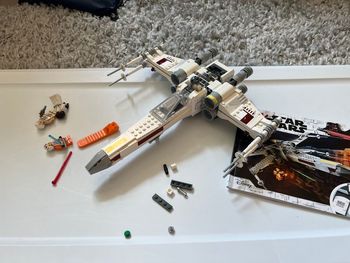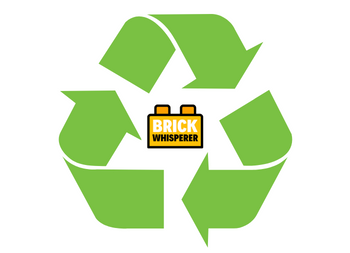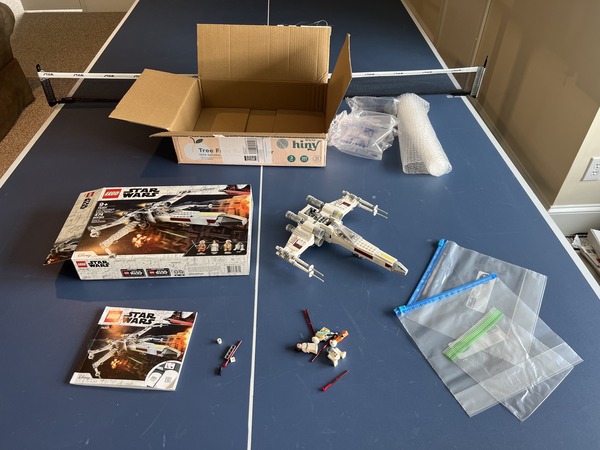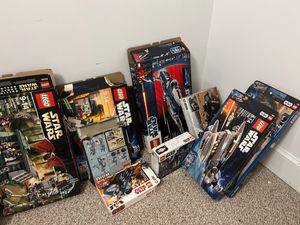Why do Lego Sets Have Extra Pieces?
Today I was building a Lego set and I, like always, ended up with a few random extra pieces. I double-checked what I built, and I am so confident that I did not miss a single piece. So, what gives? Did Lego mess up? I had to find out. I did some research and figured out why Lego Sets have extra pieces.
Lego sets are filled with conveyor belts that fill each bag with different pieces to a pre-programmed weight. This process is accurate for large elements, but not for smaller and lighter Lego pieces. Because of this, each bag is set to be filled with slightly more pieces than necessary.
This is why you hardly ever end up with an extra large brick, but plenty of tiny 1×1 bricks and so on. Just look at the X-Wing I built today, there are several very tiny extra pieces!
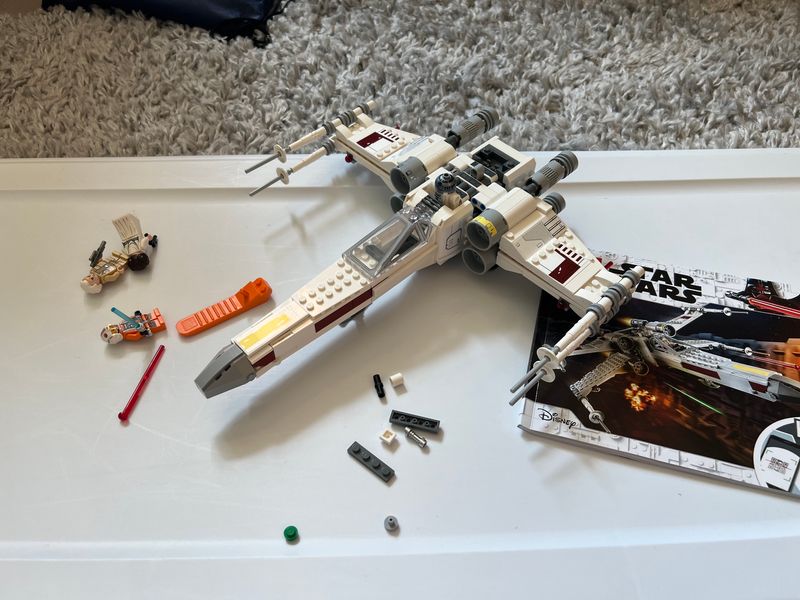
Another reason why they slightly overfill their Lego sets is because of customer support. It would be a nightmare to constantly have to refund buyers or send additional pieces when a set ends up underfilled. To avoid that, Lego strives to make sure each set has enough pieces and sometimes a bit more.
Lego Sets are not Supposed to Have Extra Pieces.
I know I just said that Legos purposefully fill their sets with a few extra tiny pieces to make up for the fact that it’s very difficult to accurately weigh the tiny Lego bricks. Just keep in mind that this is never the case for larger legos that weigh a little more, which makes them easier to measure.
Sets made for children, such as Lego Junior and Duplo, almost never have extra pieces because the bricks are larger. They are much easier to weigh, which leads to a more accurate count of pieces.
Sets may have Fewer Extra Pieces Today than they used To.
If you remember, Lego sets used to have very few bags compared to the sets we build today. I just finished building Luke Skywalker’s X-Wing Fighter (Affiliate link to Amazon), and it had 4 bags for a measly 474 pieces. Did Lego decide to become more wasteful? Why do we need all these bags?
It turns out that this is on purpose! Lego divides its sets into numerous bags, some with even smaller bags inside for the smaller pieces. This ensures that each set has the correct number of parts, and so that you don’t spend as much time searching for parts as you build.
Well, how do extra bags ensure there are enough parts? Lego fills its sets of Lego pieces with conveyor belts and scales. The conveyor fills and seals tiny bags with 1×1 bricks, studs, and other small pieces. From there, this bag of smaller pieces is thrown in with each larger bag found in the Lego set.
To make sure there is never a case where there are not enough Legos in a set, the conveyors are set to go slightly over the required weight which is the correct number of pieces in a set. This way, there are always enough pieces and oftentimes a few more than necessary.
With this, it’s possible that there are fewer extra pieces in Lego sets today than there were years ago, before the excessive amount of bags. When Lego filled all the pieces in a few bags, it was more likely that each set would receive more pieces than it should have.
The Most Common Extra Lego Pieces
The most common extra Lego element you’ll find in sets are small bricks. These include the 1×1 bricks, vent pieces, and Minifigure accessories. They are lighter than most bricks, which makes them difficult to weigh. Because of this, Lego slightly overfills sets with these bricks.
A 1×1 brick of any color (Affiliate link to eBay) is an extra piece you’ll sometimes see. Sometimes you’ll even find extra 1×1 snot-nosed bricks. They’re probably some of the heaviest extra pieces you will find, which makes them a bit rarer when it comes to extra bricks.
Lego pin connectors (Affiliate link to eBay), on the other hand, are some of the most common extra Lego pieces. They weigh next to nothing and are found in most Lego sets. The sheer number of these parts used across so many Lego Themes makes them very common.
Round Lego studs (Affiliate link to eBay), are an iconic and very common Lego element. I can confidently say that nearly every set uses this piece, and it’s been in sets dating back for over a decade. They are light and hard to weigh, which leads to lots of extras.
What to do With Extra Lego Pieces
We know why we have extra pieces, but what do we do with them? Let’s go over four things to do with all these extra Lego elements.
Add extra bricks to your Lego collection.
This may seem like the obvious option because it is. Let me tell you, I’ve been saved by having an extra Lego vent lying around when I could not find one to save my life. This has been the case with many Lego parts. This is usually because I left the brick in the bag, or let it slip off the table. Either way, It’s important to keep extra bricks in case you may need them while building other sets.
Slightly modify the set you built or any others you have.
Imagine you’re building a cool Lego Star Wars ship, and think that it could use a bit more detail. You have a few extra pieces and decide to add them to your ship. Maybe if you put this stud here, and a vent there. Before you know it, you used your extra bricks and your ship is something unique! This is the beauty of Legos, they can be whatever you dream of.
Sell the pieces on brick brokerage sites.
One option I’ll never suggest is to throw away those pieces. They are worth money! You may look at me funny if I told you that someone would buy you a cup of coffee for a few Lego studs, but they would! Look at a few examples of real transactions I found on eBay.
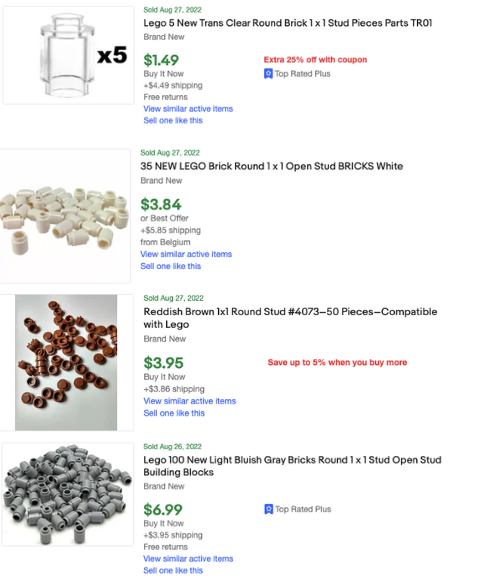
These are just a few examples. There are dozens of tiny pieces you’ll find that come extra with Lego sets. You’ll need to keep a jar or container of some sort to collect them over time, but eventually, you’ll have enough to sell.
I found that 1×1 pieces sell for more than studs. The larger and less common the piece, the more it sells for. This is why studs will sell for a bit more than a round 1×1 brick.
eBay is just one of the many sites where you can sell Lego pieces. If you want to get serious about selling Legos, I recommend you look at Bricklink.com. There, you’ll find dedicated Lego brick stores.
Donate your extra pieces to kids in need.
In an effort to give back to the community, the Lego group created The Lego Replay program. Here, they collect used or unwanted Legos and donate them to thousands of needy children in America. Two organizations that receive Legos from this program are The Boys and Girls Club of Boston and Teach for America.
The program allows anyone to ship Legos from anywhere in the United States, including Hawaii and Alaska, to their headquarters. To donate, simply fill a reasonably-sized box with various Lego pieces. Next, go to the Lego Replay website and make sure your donation fits their standards. They just want to make sure you are only sending Lego pieces and not batteries, other toys, instruction manuals, etc.
Once that’s all settled, The Lego Replay Program will pay to ship those Legos to their sorting center. You just give them your email and they will instantly email you a shipping label for your box. All you need to do is pack the Legos and bring them to the post office. Once they receive your Legos, they clean and divide the Legos into donation boxes that are then sent to the organizations I mentioned earlier.
This initiative is a great way of giving to children in need, but keep in mind they will want more than the random extra tiny pieces you find in a Lego set. While donating to this group is important, I would not send them a box full of tiny 1×1 pieces. Instead, set these extra pieces aside and wait until you have enough Legos to fill a box full. You can add any Legos you don’t end up wanting that some child will love.

